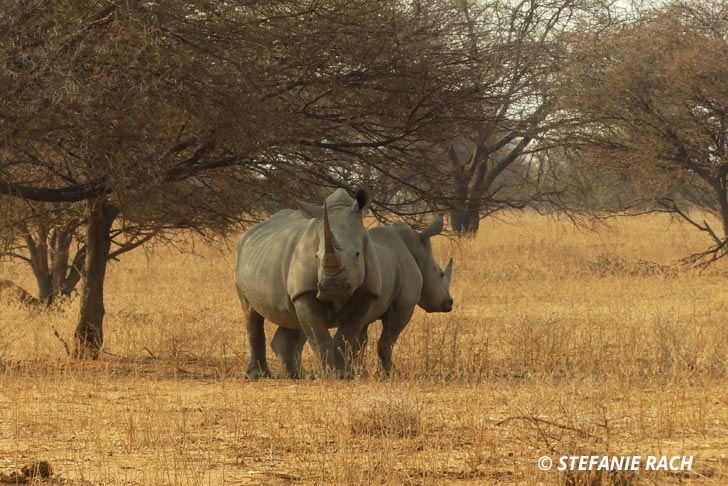Tracking Mother Nature: The Square-and the Hooked-Lipped
Maybe you have heard that in some African countries there are black and white rhinos. And maybe you have seen the black rhino and the white rhino on safari or in a documentary. And maybe you noticed that the black rhino is not black and the white rhino is not white, but both are grey. So where do the names come from? And what does that have to do with tracking?

By Stefanie Rach
You follow a barely visible game trail past trees and bushes. You have previously seen a footprint in the sand with three toes – clearly a rhino. After following this path for a while, you not only saw this footprint every now and then, but also a pile of dung in which you could still make out remains of grass. Now the trail leads to an open plain. Behind one of the bushes bordering the plain you crouch down to avoid being discovered. To be on the safe side, you check the wind direction again by letting a handful of sand trickle down. The sand blows slightly backwards and lands next to your heel. That’s good. The wind cannot carry your smell in the direction of the plain. Because two rhinos are grazing there – and even though rhinos can’t see well, they can smell and hear all the better.
With their broad mouth, the rhinoceroses cut the grass like a lawnmower. And this may be the origin of the rhino’s name: when the Dutch encountered the square-lipped rhino at the beginning of the colonial period, the Dutch word “wijd” (wide) was mistranslated into the English word “white”. Consequently, the hooked-lipped rhino was later called the black rhino – at least that is the theory.
You follow a game trail through a thicket. Again and again your clothes get caught on the thorns of the Sickle Bush. Even your skin has already received a few scratches. But it is worth it. Because black rhinos prefer to stay in such thickets. And the footprint with the three toes you saw earlier proves that one lives here. It is a bit smaller than the white rhino’s, which is because black rhinos are not as big as white ones. This time you also passed a pile of dung. It was clearly from a black rhino, because instead of grass you found small twigs in the droppings. The twigs showed a conspicuous cutting edge: they were all cut off from the bushes at an approximate angle of 45°. The black rhino’s pointed mouth works like a hedge trimmer. The rhino cuts off the branches in order to get at the leaves. While white rhinos are grazers, black rhinos are browsers. And that’s what you could see when you read the tracks on the dung. You can’t read tracks without also studying the behavior of the animals. Somewhere there is a rustling in the thicket. You stand rooted to the spot and listen: Is this perhaps the black rhino?
Every problem has a solution, every solution needs support.
The problems we face are urgent, complicated, and resistant to change. Real solutions demand creativity, hard work, and involvement from people like you.

Stay in the know.
Be ready to act.
To keep up to date with our latest news, events, marches,
campaigns and fundraising activities.
